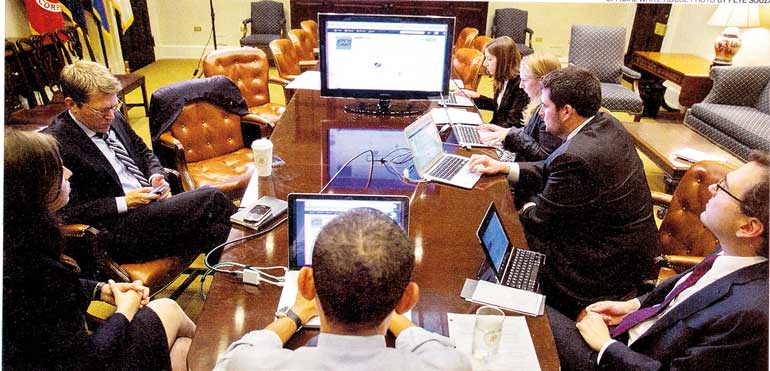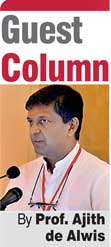Saturday Apr 19, 2025
Saturday Apr 19, 2025
Thursday, 19 May 2016 00:00 - - {{hitsCtrl.values.hits}}

In the Oval Office, FBI Director Robert Mueller (centre right), Homeland Security Secretary Janet Napolitano (far left) and other security advisers brief President Barack Obama (foreground, right) following the April 15, 2013, Boston Marathon explosions. A goal of anticipatory governance is to reduce susceptibility to future “black swans” such as these types of atracks.

President Barack Obama (foreground, centre) demonstrates a facility with networking by participating in a live Twitter question-and-answer session at the White House in December 2012. Part of improving government’s anticipatory capabilities will include enhancing all forms of networking between agencies and among staffers tasked with foresight and the policy advisors to whom they report.
 The famous Brundtland Report carried the title ‘Our Common Future’. When nations met and issued a communiqué at the Rio+20 global environmental summit it had the interesting title ‘The Future We Want’. When countries met in New York and issued a communiqué after the launch of the Sustainable Development Goals for the next 15 years, the ethical imperative for the process was termed as ‘Leaving No one Behind’.
The famous Brundtland Report carried the title ‘Our Common Future’. When nations met and issued a communiqué at the Rio+20 global environmental summit it had the interesting title ‘The Future We Want’. When countries met in New York and issued a communiqué after the launch of the Sustainable Development Goals for the next 15 years, the ethical imperative for the process was termed as ‘Leaving No one Behind’.
All these are interesting and quite philosophical reports with titles having the ability to address directly to the heart too. These are documents coming out from meetings of nearly 192 nations of the world but we know that some are closer to action than a lot of others in organising the contents of these documents. When it boils down to action, the actions may not necessarily reflect the titles of the documents. There is definitely the necessity for individual nations to look after themselves and their citizens. There are of course international partnerships that are developed in order to help the needy but purely banking on such will not be sufficient. We do not have Marshall Plans coming out every day!
Where Sri Lanka wants to be
As such, it is important that Sri Lanka too consider where it wants to be beyond the rhetoric. We do have to map our way, plan for what we want and where we want to be. It is too common to see that fire fighting is our usual preoccupation. We see and hear decisions taken in the morning, facing opposition by the afternoon and about turns on the decisions by the next morning. Such situations beg the question - how much of thinking, planning and understanding went in prior to taking that decision and announcement. Hasty retreats unceremoniously carried out never leave a good taste with the recipients or a good mark for the doer. We hear the term scoring own goals and members of the own goal team – while we may be laughing from a political perspective they are no laughing matter from a national standing.
This month, for two days in Colombo, there will be the National Innovation Summit hosted by the United Nations Development Program (UNDP) – ‘Foresight and Innovation for Sustainable Human Development on 24 and 25 May at Water’s Edge. UNDP’s Sri Lankan mission has invested significant time and effort in really trying to introduce a concept worthy of integration to everything we do. Have foresight and innovate always; these are two ingredients of utmost importance to our economy and society. Well, they are going to take the ‘horse’ to the water for sure and let us look forward to seeing the ‘horse’ enjoying the resources provided with pleasure. UNDP, in executing the program, has a group of core partners. The array of international resource pools that have been duly assembled is quite different from the usual fare. They are case studies for emulation straight away. The core partners with UNDP are – Ministry of National Policies and Economic Affairs, the Coordinating Secretariat for Science, Technology, and Innovation (COSTI) of Ministry of Science Technology and Research, Sarvodaya, LIRNEasia, United Nations Global Compact (UNGC) and Ceylon Chamber of Commerce (CCC). The international resource partners come from UNDP Bangkok Regional Hub, UN Pulse Lab Jakarta, UNDP Centre for Public Service Excellence – Singapore, Mind Lab – Denmark, GIZ – Germany, Superflux – UK, UNDP Kolba Lab – Armenia, UNDP MiLab – Moldova and myForesight – Malaysia.
Pioneers in this area will be in Colombo. As sustainable development goals are addressed within this program from a country perspective the private sector engagement is from Ceylon Biscuits Ltd., Holcim, Aitken Spence, SriLankan Airlines, Virtusa, MAS, Dilmah, Jetwing, Unilever, DNV-GL, Hatton National Bank Grameen, Maga, John Keells Holdings. Definitely the event should prove to be exciting and an excellent learning opportunity for the participants.
Foresight considers generating future pathways based on understanding of the trends, forecasts. The understanding should lead to a desired snapshot of the future carried out with ‘big-picture thinking’. Can we instil within planning and other agencies anticipatory leaders or such attributes in their leadership teams? Can we realise anticipatory governance from our system of governance? May we realise public sector innovations, policy innovations etc.? There is a host of expectations to be had, when we go down this particular road.
Understanding foresight
Such thinking would enable finding opportunities even when the possibilities are bleak and doom and gloom scenarios abound. It is only if we think and plan that we would be able to go past such possibilities as we would not be blind. ‘Foresighting’ is a disciplined exercise. It must be understood that ‘foresighting’ is not prediction. It is not simply vision or the display of an innate intelligence. Foresight is a distinct process of monitoring prospective oncoming events, analysing potential implications, stimulating alternative courses of action, asking unasked questions, and issuing timely warnings to avert risk or seize an opportunity (Fuerth and Faber, 2013). Inculcating this process at an organisational level is not quite difficult and today there are consultancy companies too that are lined up to serve in this regard. At a national level – which is quite important – it is a different challenge altogether but a challenge worth taking which UNDP and the core partners believe would happen at the end of the two day summit. This really is a hope as the top level leadership is expected to participate at the end of the event to hear on outputs and the recommendations. Many a political and cultural element may need to be addressed while implementing. Bridging foresight to the policy process definitely requires creating the right interface too. Too much planning (i.e. meetings) and too little action (i.e. executions) is something quite familiar to us and that is one major reason for us being where we are today. I am being just great in hindsight!
Just consider the three pictures coming from the US – the land from which the foresight exercise originated initially for military reasons. Notebooks out, pens and paper in use at high level meetings as shown in two of the pictures, except perhaps for the use of the mobile phone in one, is quite absent in our landscape or we just do not get such official photo releases. Hope the pictures stir up some thinking.
Yes, we live in a land which at times appears to support the old adage ‘the more things change, the more they stay the same’. The nostalgic feelings at times can certainly be appreciated in some quarters if the conditions stay the same but for sure not in all areas.
Foresight and innovation
Foresight coupled with innovation should really challenge the status quo as innovators are empowered to create the future we want. Thus linking foresight with the innovation process is envisaged for maximum efficiency and not letting loose innovators for anything and sundry. Today the pace of technological advancement is exponential and thus has the potential to offer us significant opportunities. In an exponential environment, adhering to a linear change such as 10% more this time is not productive planning. We have currently the habit of using historical trends more as guidance for future planning. You can almost say that there is not much use of studying history as there is really no future in it. It is the exponential nature that takes the future relevance out of history.
Two days of meetings may lead to some meeting of minds and development of some key networks. The converts to the concept are important. The catalysts then need to carry out their role. The Government definitely needs professionals who are proficient in foresight. More understanding of the mechanisms needs to come in and will require development centres for this particular human resource. Organisations need more learning as anticipatory futures just do not come out of thin air. More feedback loops from ground level activities to board level meetings are necessary. One may find totally different organisations as a result and that would not be bad at all from an economical perspective. There is the need to commend UNDP, Colombo and its band of youth leaders for the commendable effort for this event with much future potential. With foresight, the nation as a whole would never surrender to any adverse development with only cries for help!